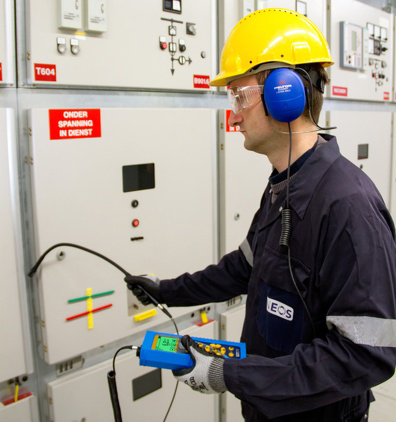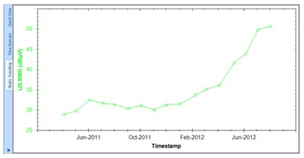I often hear the question, “what can I detect with ultrasound?”. The fact is, ultrasound is such a versatile condition monitoring technology we tend to ask it to do things beyond its capabilities. And that’s fine because I firmly believe every technology should be pushed beyond its limits. It’s how we get better.
But to help answer the question, “what can I detect?”, I ask a simple question in return. Is your application FIT?
Now you’re asking “what does he mean by is it FIT”?
Let me explain. FIT is an acronym for Friction, Impacting, and Turbulence. Basically, if the defect you are searching for generates any of these three phenomena, then ultrasound is a solution FIT to solve your problem.
Let’s try a super easy example. You are tasked with finding compressed air leaks in your factory. Air lines run every which way throughout your deafeningly noisy plant so you can’t hear the leaks. You could run your hand along all the pipes and anywhere you feel the cool air rushing out you’d know you found a leak. Or you could spray soapy water on the pipe joints and look for bubbles. A third solution could be to wait for a plant shutdown and listen for the turbulent flow of air leaks when everything is quiet.
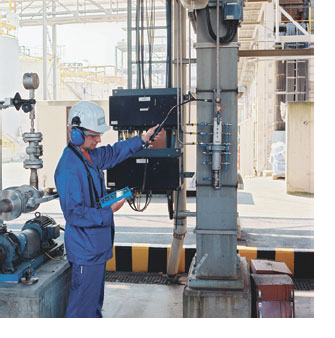
The BEST solution is to ask, “do compressed air leaks produce Friction, Impacting, or Turbulence?”. That’s it! Due to the difference in pressure on either side of the compressed air line, anywhere there is a leak there is turbulent flow. Ultrasound detectors are really good at detecting turbulent flow in high noise environments. There’s no need to run your hand along the pipe, reach for the bubble solution, or wait for a shutdown. Go grab your SDT Detector and start tagging leaks today.
by Allan Rienstra - SDT Ultrasound Solutions
Reposted from ReliabilityWeb
One method of detecting vacuum leaks is to use airborne ultrasound detection, a technology already widely used for positive ultrasound leak detection in compressed air systems. But finding vacuum leaks is not as straightforward as finding pressure leaks, and oftentimes, the method is abandoned in frustration.
One problem here is the quality of the ultrasonic instrument which can vary significantly from one manufacturer to another. Lesser quality detectors cannot function well in high noise situations. They simply have difficulty differentiating a leak sound from ambient plant noise. Since vacuum pumps already generate a lot of background noise, rarely will an inspector perform vacuum leak inspections in a quiet atmosphere. Another problem is the lack of inspector training which really plays a role when searching for vacuum leaks in high noise environments.
Just like positive pressure leaks, vacuum leaks produce a rushing, whooshing ultrasonic signal with peaks around 35-40 kHz. The ultrasound is caused by the turbulent flow of air molecules at the leak site. Positive pressure leaks, such as those found in compressed air systems, push the turbulent flow outward making them easily detectable from several feet with a quality ultrasound tool. Vacuum leaks behave quite the opposite, drawing the turbulent flow inward, decreasing the distance of detection as compared with positive pressure leaks. Most of the telltale leak sound is contained within the body which means inspectors must diligently trace an entire installation leaving no stone unturned in the search for ingress.
Read the full story by Allan Rienstra – SDT International and Karl Hoffower – Failure Prevention Associates including details and photos for a Vacuum Leak Inspection on Multiple Effect Evaporator at major Pacific Northwest Pulp & Paper Mill.
by Allan Rienstra - SDT Ultrasound Solutions
For rotating machines, it is necessary to reduce friction most of the time to increase efficiency, decrease power losses and support loads. The element of choice is the well known team of bearing and lubricant. Bearings, in their different configurations, are one of the most efficient ways to reduce friction between a stationary and a rotational part of a mechanism.

Two broad classes of bearings exist: plain bearings and rolling contact bearings. Which type of bearing is used depends on several factors related to the design of the machine and its process. Sometimes both types are used in the same machine doing different jobs. For this article, the focus is on plain bearings.
Choosing the best technology to monitor friction and condition in plain bearings is a challenge. Due to the physical characteristics of plain bearings, using vibration analysis (VA) is more effective for rolling contact bearings and less so for plain bearings. Ultrasound (US) is trending more frequently for condition monitoring of rolling contact bearings and it also shows promise for plain bearings. Understanding the physical differences between the two bearing categories is critical for developing condition monitoring strategies for plain bearings using ultrasound.
Read on to find out more about plain bearing types, failure modes and how to monitor.
by Ana Maria Delgado, CRL
When monitoring your bearing lubrication with ultrasound, it is important to watch for very high values in your condition indicators (total RMS and Peak values). After applying grease, both values should decrease proportionately. This is a sign the bearing was under-lubricated. If the total RMS value lowers and the peak value stays relatively the same, then the bearing has a mechanical condition that is generating impacts.
by Allan Rienstra - SDT Ultrasound Solutions
In today’s modern world information is found all around us and it is available at the simple push of a button; 24/7/365. Machine condition monitoring systems (online systems) have been around for quite a while, but they have typically been reserved for the most critical and most expensive machines at a facility. These critical assets typically comprise a small number of the total assets at most manufacturing plants. The majority of machines fall under the walk-around monitoring approach. If a condition monitoring program is being conducted at a world-class level then each machine is being tested monthly, however, at most manufacturing facilities manpower constraints restrict monitoring to quarterly or in some cases once or twice a year. Machines that have been historically confined to a walk-around type program can now be monitored successfully using an online system.
These systems can monitor and trend vibration levels as well as monitor and trend ultrasound and temperature.
The online systems can be configured to deliver a machine’s alarm status directly to the plant process control system. This allows the machine operator to take the necessary corrective actions. The alarm status can also be delivered to a maintenance supervisor via cell phone message or email. Using online systems to monitor the health status of your process equipment will allow the identification of problems early with minimal manpower so that catastrophic failures can be prevented which ultimately leads to less machine downtime for repairs and increased cost savings.
by Dave Leach CRL CMRT CMRP
May 2017 – Processing Magazine
This validated condition monitoring technology is versatile and inexpensive with a low learning curve.
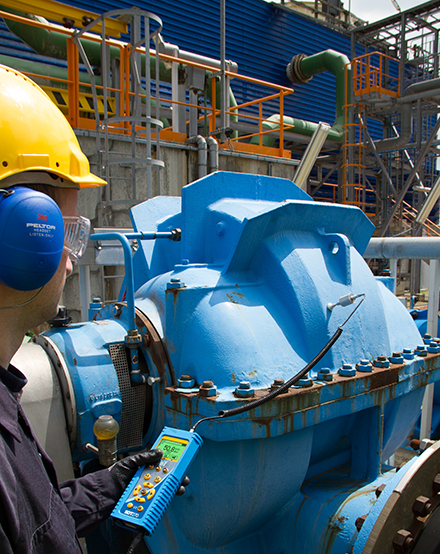
Solving asset reliability issues becomes stymied when leadership is ambivalent about the benefits of adopting multiple technologies for condition monitoring (CM). When they do adopt them, they quickly learn technologies alone are not enough without the manpower to deploy them. One colleague stoically relayed his frustration when he said, “There are never enough of us (manpower), but there are more of them (problems) every day.”
Monitoring asset condition cannot be carried out effectively with only one CM technology, yet many maintenance departments rely predominantly on data from “just vibration” or “just oil analysis,” for example. More than one failure mode threatens asset health, and not every symptom is detectable by the same method. Some organizations have a strong vibration program but not anything more. Others may see clearly with infrared thermal imaging but lack a good oil analysis solution. A broader focus nets greater results.
Implementing several CM technologies is practical but often restricted by available manpower, budget, and lack of conviction from all departments. If this is your plant’s reality, perhaps start with the most versatile technology — the one that detects the most defects — with the shortest learning curve. Choose ultrasound first and build a program on that foundation.
Read my entire article to learn about the Benefits of Ultrasound, Reliability & Operational Excellence and Where is Ultrasound Useful?
by Allan Rienstra - SDT Ultrasound Solutions

Problem:
Maintenance had no way of diagnosing if a hydraulic actuator had failed or not. On commercial aircraft, actuators are used to move many important pieces of the aircraft (A/C). If an actuator was thought to be at fault, the engineers would order the replacement of ALL of the actuators in the region of the fault. This would cost several days of maintenance man-hours, lost A/C revenue, and the removal and replacement of parts that work fine.
Solution:
Use the SDT270 ultrasound detector with the RS-1 contact probe to listen to each of the actuators. By comparing the sounds of working actuators to failed actuators, the maintenance staff was able to remove and replace the ones that are truly broken.
Result:
Problems found in minutes versus days. The maintenance staff was extremely happy to have a new tool that could point to the source of the problem so quickly.
Special thanks to Karl Hoffower from Failure Prevention Associates, LLC. for sharing this success story with us!
by Ana Maria Delgado, CRL
Compressed air is one of the three highest-cost utilities in use at your plant. It is also one of the least maintained in terms of system leaks. Leaks are expensive and wasteful, but most often ignored.
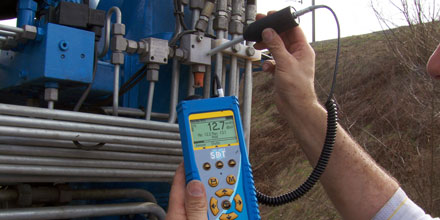
Finding and fixing leaks is an easy way to reduce energy costs but finding them is not easy because of background noise.
- Why we don’t find and fix air leaks?
Leaks are often considered an unavoidable cost of business. Many of us simply don’t realize the high cost of compressed air leaks. - Air leaks cost you real money
Compressed air leaks are one of the leading expenses in the industrial world to this day. Leaks are a source of wasted energy, but they also contribute to other operating losses. - How much air is being wasted?
Air leaks are wasted energy. An industrial compressed air system loses up to 40% of its compressor’s output to leaks if left unchecked. - The best way to find leaks
SDT’s ultrasound technology provides you with the ability to check vast areas for air leaks quickly and effectively. The SDT270 hears high-frequency sounds created by leaks while ignoring low-frequency plant noise. - How to fix compressed air leaks
Finding the leaks presents a solution to the problem. But only fixing the leaks nets cost and energy savings. Without a follow-up to ensure found leaks were actually fixed, leak detection is just another expense. - Air leak prevention program
Implementing an Air Leak Prevention Program in your facility is essential for energy and cost savings. Proactive leak detection and good organization will reduce leaks to 10% or less of system demand.
Download our Leak Surveyors Handbook
by Allan Rienstra - SDT Ultrasound Solutions
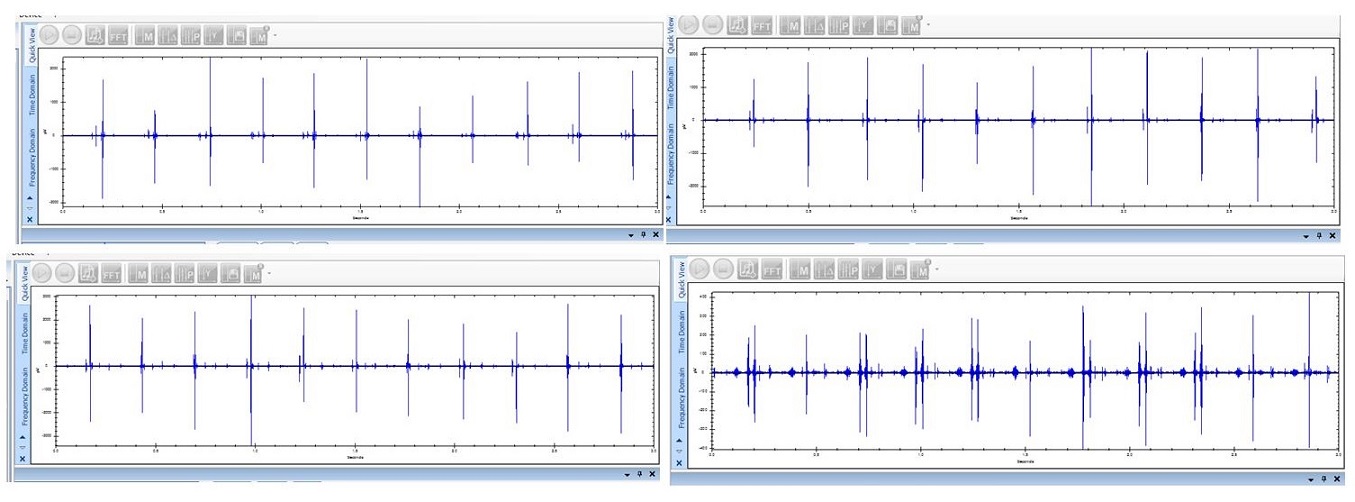 On a recent plant visit, our solutions provider Bob Dunn with I&E Central, Inc. used the SDT 270 ultrasound instrument and a contact sensor to inspect and capture waveforms on a series of valves on an automated manufacturing machine. The results were a revelation!
On a recent plant visit, our solutions provider Bob Dunn with I&E Central, Inc. used the SDT 270 ultrasound instrument and a contact sensor to inspect and capture waveforms on a series of valves on an automated manufacturing machine. The results were a revelation!
These valves open every 0.25 seconds and pass a brief pulse of air into the process. There were six valves, a 3-second signal was acquired on each. When we viewed the .wav files, one was significantly different from the rest, 4 examples are shown. Valve # 5 was passing a “double” pulse on most of its cycles.
Comparing signatures or levels on like components is a valuable diagnostic approach. At this point, the underlying cause has not been determined, but it is likely a worn component, and the valve should at the least be inspected further and possibly replaced. The failure of one of these valves would stop production on a high-speed automated line.
Properly applied, ultrasound gives you great insight into many types of assets!
by Ana Maria Delgado, CRL
- Most electrical cabinets are not hermetically sealed. Scan your ultrasound detector around the panel sides and ventholes to detect discharges like arcing, tracking, and corona.
- Not all electrical discharge faults produce heat. Use ultrasound solutions to hear what your infrared camera cannot see.
- Electrical discharge activity is amplified by high humidity. When performing ultrasonic scans at substations make note of the date and weather conditions.
- Ultrasound travels directionally through air compared with an audible sound. When scanning from a distance, therefore, it is important to inspect electrical systems from all sides.
- Corona discharge produces no heat on electrical systems below 240 kV so don’t rely entirely on infrared to find problems.
by Allan Rienstra - SDT Ultrasound Solutions
As Published by Maintenance Technology Magazine March 2017 issue

When it comes to electrical systems, most failures can be attributed, in large part, to installation problems, water damage, insulation issues, or poor workmanship. Such failures pose a serious safety threat and have the ability to shut down operations entirely. Ultrasound technology is a proven way to deal with them. In short, this easily deployed predictive tool offers sites a means of identifying and, thus minimizing the impact of these problems.
Read the full case study and learn how Brian Franks from JetTech Mechanical located an electrical fault with the SDT270 ultrasound system at a major water municipality.
by Yolanda Lopez
Bearings produce less friction when they are properly lubricated. But how do we know?
- How can you be confident that friction forces are where they should be?
- How can you confidently apply just the right amount of grease to return friction levels to normal?
- How can you distinguish between a bearing that needs grease and a bearing that is failing?
How does Ultrasound help?
Using an ultrasound measurement tool with digital decibel metering is a proven method for:
- Establishing a historical baseline for friction levels
- Monitoring changes in friction levels at regular intervals
- Triggering alarms when friction levels elevate
- Evaluating data to differentiate failure from friction
Our ultrasound solutions are designed for budget-minded inspectors. However, attention to detail, robustness, and quality have not been sacrificed at the expense of low prices. Equipped with needle and threaded contact sensors, acoustic lube adapter, and multi-surface magnet, our SDT systems answer the basic needs of lubricators. The non-contact temperature sensor can be used for additional control of bearing condition prior to and after lubrication.
Download our Ultrasound Lubrication Technician Handbook.
by Allan Rienstra - SDT Ultrasound Solutions
Rotating equipment produces a sound (ultrasonic) signature during operation. This signature can be measured and trended over time. As the machine components begin to fail a change in the ultrasonic signature will occur.
The change in sound level can be used to alarm that could be related to lubrication or bearing damage. A key factor to using an ultrasound tool successfully to determine machine health is collecting the measurements at the same location every time. The first step is to identify a measurement test point for each bearing to be monitored.
One method for data collection is to use a magnet that should be attached to a metal pad epoxied to the measurement location. The use of a magnet and mounting pad will allow for repeatable and consistent data for accurate trending and alarming. If access to measurement locations is restricted, then a sensor can be permanently installed so that measurements can be taken remotely. Ultrasound is an extremely valuable tool that can be used to detect bearing problems with slow-speed applications.
Ultrasound is an important part of any reliability-based condition monitoring program and can provide early warning of mechanical failure. This early warning can lead to reduced downtime and increased plant reliability.
by Dave Leach CRL CMRT CMRP
The basic concept of CBM (Condition Based Maintenance) is to monitor the condition (CM) of a machine over time and use conditional data to predict the need for maintenance to take action (PdM). Let’s apply this concept to the re-lubrication of rolling element bearings.
Using an SDT ultrasound instrument (simple or advanced), lube-techs collect data that indicates the current condition of the bearing. What are some of the Condition Indicators collected by SDT? Simple “STATIC” Condition Indicators. Ultrasound STATIC data provides an instantaneous snapshot of bearing condition.
- RMS – The average of the ultrasound signal over the duration of the measurement time
- Max RMS – The highest RMS signal observed over the duration of the measurement time
- Peak – The highest amplitude observed over the duration of the measurement time
- Crest Factor – A linear ratio between the Peak and the RMS (CF=Peak/RMS)
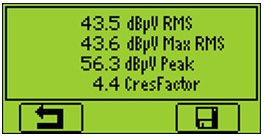 Use the RMS condition indicator to determine lubrication intervals and guide you while slowly applying grease to a bearing. For example:
Use the RMS condition indicator to determine lubrication intervals and guide you while slowly applying grease to a bearing. For example:
- Correctly greased: RMS = 35.2 dBµV
- Under-greased: RMS = 45.8 dBµV
by Allan Rienstra - SDT Ultrasound Solutions
As Published by COMPRESSORtech2 Magazine October 2016 issue
by Karl Hoffower – Condition Monitoring and Reliability Expert for Failure Prevention Associates
Combining ultrasound and vibration sensing adds precision to recip valve analyses
Over the past decade, ultrasonic condition monitoring of reciprocal compressor valves has become more widely known. However, it does not seem to be widely used.
Ultrasonic testing measures high-frequency sound waves, well above the range of human hearing.
These ultrasound devices record the high-frequency signals for analysis later. Trending valve cap temperatures is the most common condition monitoring technique for monitoring
compressor valve health.
Ultrasonic testing of compressor valves and vibration monitoring of rotating components is an informative, preventative-maintenance practice. Compressor valve deficiencies with opening, closing, or leaking may be diagnosed using the ultrasound recording functions.
Steven Schultheis, a Shell Oil Co. engineer, addressed the issue in a paper presented at the 36th Turbomachinery Symposium in Houston in 2007.
“Trending valve temperatures have proven to be valuable in identifying individual valve problems, but are most effective if the measurement is made in a thermowell in the valve cover.” Schultheis wrote. “Ultrasound has proven to be the preferred approach to the analysis of valve condition.”
Failure Prevention Associates completed an experiment with a major midstream gas transmission company to see if this type of condition monitoring tool can effectively find fault conditions well before another technology is used.
Ultrasound meters (such as the SDT270 from SDT Ultrasound Solutions) have digital readouts that indicate the level of ultrasound detected. These devices have been used for decades to “hear” air, gas, and vacuum leaks. The intensity or amplitude of the signal is expressed in decibels — microvolts. (dB[A] μV). The dB(A) is a common intensity unit for sound intensity; μV designates the engineering reference unit being used with a piezoelectric sensor.
Converting an airborne ultrasound detector with a contact sensor allows a technician to monitor what is happening inside a machine, whether it is a bearing, steam trap, or valve.
Ultrasound detectors are designed to operate in a specific and narrow frequency band. Then through the “heterodyning” step high frequency sounds down into an audible format that the technician can hear through headphones. During the heterodyning process, the quality and characteristics of the original ultrasound signal are preserved.
Read full article complementary-condition-monitoring-boosts-reliability-article
by Yolanda Lopez
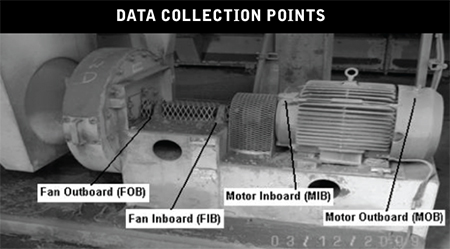 To facilitate the initial learning curve, a labeling system was implemented to help technicians collecting data identify bearings that were part of the initial survey. These descriptors were laminated to prolong their life in the unfriendly environment of a typical cement plant. Standard locations for data collection needed to be understood since labels would become difficult or impossible to read over time.
To facilitate the initial learning curve, a labeling system was implemented to help technicians collecting data identify bearings that were part of the initial survey. These descriptors were laminated to prolong their life in the unfriendly environment of a typical cement plant. Standard locations for data collection needed to be understood since labels would become difficult or impossible to read over time.
On-the-job training included an understanding that readings collected on the drive motor bearings needed to be collected from the grease fitting on the non-drive end and from the upper portion of the end bell housing on the drive end. On driven equipment bearings, where direct access was possible, the ultrasound readings were to be taken in the horizontal plane directly from the bearing housing. (Note: with ultrasound, it is not necessary to record data from multiple planes on the same bearing). Technicians were trained to take ultrasound readings as close to the bearing as physically possible while respecting personal safety.
This simple label proved important to the integrity of the pilot project to prevent greasing from well-intentioned lubricators.
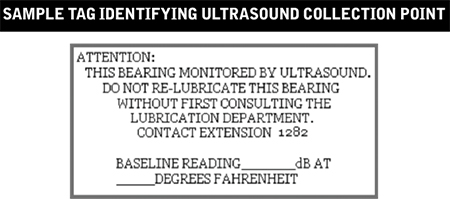
by Allan Rienstra - SDT Ultrasound Solutions

LUDECA is proud to announce that effective October 14, 2016, LUDECA is certified as an authorized SDT Service and Repair Center for the United States.
Our factory-trained technicians are highly experienced and committed to providing our customers with excellent service.
We look forward to servicing your SDT ultrasound products at our Doral, Florida location.
For more information, visit our website.
by Ana Maria Delgado, CRL
Compressed air represents one of the highest utility costs in industrial plants. It’s also one of the most misunderstood; which explains why leaks account for, on average, as much as 35-40% of total demand.
Leaks are often considered an unavoidable cost of business. Many of us simply don’t realize the high cost of compressed air leaks.
Add to that the fact that:
- Leaks don’t present a visible threat to safety
- Leaks don’t make a mess on the floor
- They are invisible
- We can’t hear them over the other noise in the plant
- We don’t need permission to open a 1/4” air line and waste thousands of dollars per year
Remove our misconceptions about the high costs of leaks and we create a huge opportunity to save money, increase environmental sustainability, and drove positive culture change.
Download the Leak Surveyors Handbook to learn more.
by Allan Rienstra - SDT Ultrasound Solutions
Ultrasound is an essential part of a proactive reliability program as it can reduce or eliminate wasted compressed air through leak detection and repair. This Infographic outlines an effective way to survey your systems and detect leaks and brings you one step closer to best practices for your ultrasound program.

Download Infographic
by Ana Maria Delgado, CRL
Like any job, there is a right way and a wrong way to do things. Simply listening to a bearing with an ultrasound device that gives no quantitative feedback is a recipe for disaster. The audible feedback is too subjective to draw any comparative conclusions. No two people hear the same and there is no way to remember what the bearing sounded like a month ago.
The third mistake is depending solely on subjective ultrasound data when precise quantifiable data is available.
Always use an ultrasound instrument with digital decibel metering. Better still, use a device that provides multiple condition indicators. Max and Peak RMS decibel measurements indicate alarm levels and greasing intervals while Ultrasonic Crest Factor provides insight about the bearing condition in relation to its lubricant. Crest factors help us differentiate between bearings that need grease and bearings that need to be replaced.
Download the Ultrasound Lubrication Technician Handbook
by Allan Rienstra - SDT Ultrasound Solutions

